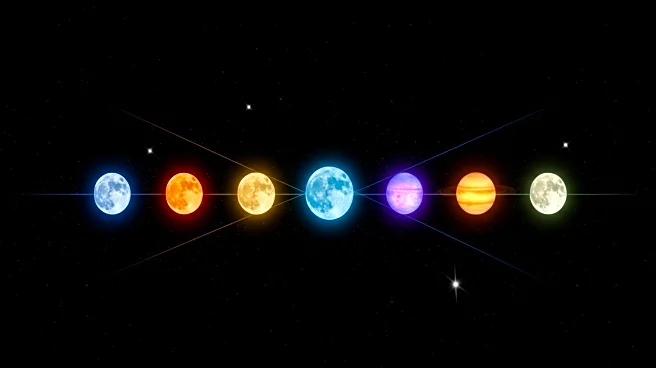What's Happening?
A rare celestial event known as a 'planet parade' will occur this August, featuring six planets visible in the night sky. Starting on Sunday, August 17, and continuing through Wednesday, August 20, Mercury, Venus, Jupiter, Saturn, Uranus, and Neptune will appear together in the eastern sky about an hour before sunrise. While Mercury, Venus, Jupiter, and Saturn can be seen with the naked eye, Uranus and Neptune require a telescope due to their dimness and distance. The event is enhanced by the presence of a waning crescent moon, which will rise above Jupiter and Venus on August 17 and 18. This planetary gathering, last seen in February, offers a unique opportunity for skywatchers to observe multiple planets simultaneously.
Why It's Important?
The occurrence of a six-planet parade is a relatively rare astronomical event, providing a unique opportunity for both amateur and professional astronomers to observe and study the alignment of these celestial bodies. Such events can spark public interest in astronomy and science, encouraging educational activities and community engagement. The visibility of multiple planets at once can also aid in understanding planetary motion and dynamics. For those interested in photography, the event offers a chance to capture stunning images of the night sky, potentially contributing to scientific documentation and public awareness of astronomical phenomena.
What's Next?
As the planet parade progresses, Mercury will gradually become more difficult to see as it falls back into the sun's glare by August 21. Observers are encouraged to take advantage of the clear skies and optimal viewing conditions during the event. Looking ahead, two more six-planet parades are expected in 2026, one after sunset in February and another before sunrise in August, providing further opportunities for observation and study.
Beyond the Headlines
The planet parade highlights the intricate dance of celestial bodies in our solar system, offering insights into the gravitational interactions and orbital mechanics that govern planetary motion. It also underscores the importance of preserving dark skies, free from light pollution, to ensure the visibility of such events. The cultural and educational impact of witnessing a planet parade can inspire future generations to explore the sciences and appreciate the natural wonders of the universe.

